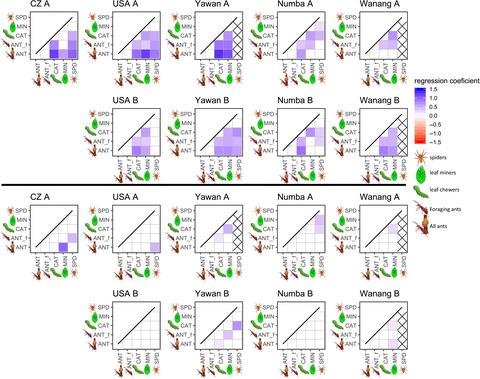当前位置:
X-MOL 学术
›
Ecol. Lett.
›
论文详情
Our official English website, www.x-mol.net, welcomes your
feedback! (Note: you will need to create a separate account there.)
Spatial covariance of herbivorous and predatory guilds of forest canopy arthropods along a latitudinal gradient.
Ecology Letters ( IF 7.6 ) Pub Date : 2020-08-18 , DOI: 10.1111/ele.13579 Ondrej Mottl 1, 2, 3 , Pavel Fibich 1, 2 , Petr Klimes 1 , Martin Volf 1, 4 , Robert Tropek 1, 5 , Kristina Anderson-Teixeira 6, 7 , John Auga 8 , Thomas Blair 6 , Phil Butterill 1, 2, 5 , Grace Carscallen 9 , Erika Gonzalez-Akre 6 , Aaron Goodman 6 , Ondrej Kaman 1 , Greg P A Lamarre 1, 2, 7 , Martin Libra 1, 2 , Maria E Losada 10 , Markus Manumbor 8 , Scott E Miller 10 , Kenneth Molem 8 , Geoffrey Nichols 6 , Nichola S Plowman 1, 2 , Conor Redmond 1, 2 , Carlo L Seifert 1, 2 , Jan Vrana 11 , George D Weiblen 12 , Vojtech Novotny 1, 2
Ecology Letters ( IF 7.6 ) Pub Date : 2020-08-18 , DOI: 10.1111/ele.13579 Ondrej Mottl 1, 2, 3 , Pavel Fibich 1, 2 , Petr Klimes 1 , Martin Volf 1, 4 , Robert Tropek 1, 5 , Kristina Anderson-Teixeira 6, 7 , John Auga 8 , Thomas Blair 6 , Phil Butterill 1, 2, 5 , Grace Carscallen 9 , Erika Gonzalez-Akre 6 , Aaron Goodman 6 , Ondrej Kaman 1 , Greg P A Lamarre 1, 2, 7 , Martin Libra 1, 2 , Maria E Losada 10 , Markus Manumbor 8 , Scott E Miller 10 , Kenneth Molem 8 , Geoffrey Nichols 6 , Nichola S Plowman 1, 2 , Conor Redmond 1, 2 , Carlo L Seifert 1, 2 , Jan Vrana 11 , George D Weiblen 12 , Vojtech Novotny 1, 2
Affiliation

|
In arthropod community ecology, species richness studies tend to be prioritised over those investigating patterns of abundance. Consequently, the biotic and abiotic drivers of arboreal arthropod abundance are still relatively poorly known. In this cross‐continental study, we employ a theoretical framework in order to examine patterns of covariance among herbivorous and predatory arthropod guilds. Leaf‐chewing and leaf‐mining herbivores, and predatory ants and spiders, were censused on > 1000 trees in nine 0.1 ha forest plots. After controlling for tree size and season, we found no negative pairwise correlations between guild abundances per plot, suggestive of weak signals of both inter‐guild competition and top‐down regulation of herbivores by predators. Inter‐guild interaction strengths did not vary with mean annual temperature, thus opposing the hypothesis that biotic interactions intensify towards the equator. We find evidence for the bottom‐up limitation of arthropod abundances via resources and abiotic factors, rather than for competition and predation.
中文翻译:

森林冠层节肢动物的食草性和掠食性行会沿纬度梯度的空间协方差。
在节肢动物群落生态学中,物种丰富度研究往往优先于那些研究丰度的模式。因此,关于树栖节肢动物丰度的生物和非生物驱动因素仍然知之甚少。在这项跨大陆研究中,我们采用一个理论框架来检验食草和掠食性节肢动物行会之间的协方差模式。在9个0.1公顷的森林地中,对1000棵以上的树木进行了嚼叶和采食草食动物以及掠食性蚂蚁和蜘蛛的调查。在控制了树木的大小和季节之后,我们发现每块公会的丰度之间没有成对的负相关关系,这表明公会间竞争和食肉动物对草食动物的自上而下调节的微弱信号。行会间的互动强度并没有随年平均温度变化,因此反对生物相互作用向赤道加剧的假说。我们发现了通过资源和非生物因素实现节肢动物丰满度自下而上限制的证据,而不是竞争和掠夺的证据。
更新日期:2020-09-24
中文翻译:

森林冠层节肢动物的食草性和掠食性行会沿纬度梯度的空间协方差。
在节肢动物群落生态学中,物种丰富度研究往往优先于那些研究丰度的模式。因此,关于树栖节肢动物丰度的生物和非生物驱动因素仍然知之甚少。在这项跨大陆研究中,我们采用一个理论框架来检验食草和掠食性节肢动物行会之间的协方差模式。在9个0.1公顷的森林地中,对1000棵以上的树木进行了嚼叶和采食草食动物以及掠食性蚂蚁和蜘蛛的调查。在控制了树木的大小和季节之后,我们发现每块公会的丰度之间没有成对的负相关关系,这表明公会间竞争和食肉动物对草食动物的自上而下调节的微弱信号。行会间的互动强度并没有随年平均温度变化,因此反对生物相互作用向赤道加剧的假说。我们发现了通过资源和非生物因素实现节肢动物丰满度自下而上限制的证据,而不是竞争和掠夺的证据。











































 京公网安备 11010802027423号
京公网安备 11010802027423号